Learn how to make a quiche crust from scratch in just a few easy steps. This perfect quiche dough recipe yields a flaky, buttery, delicious crust also known as pate brisee. Below are helpful step-by-step instructions with photos and a detailed quiche crust recipe.
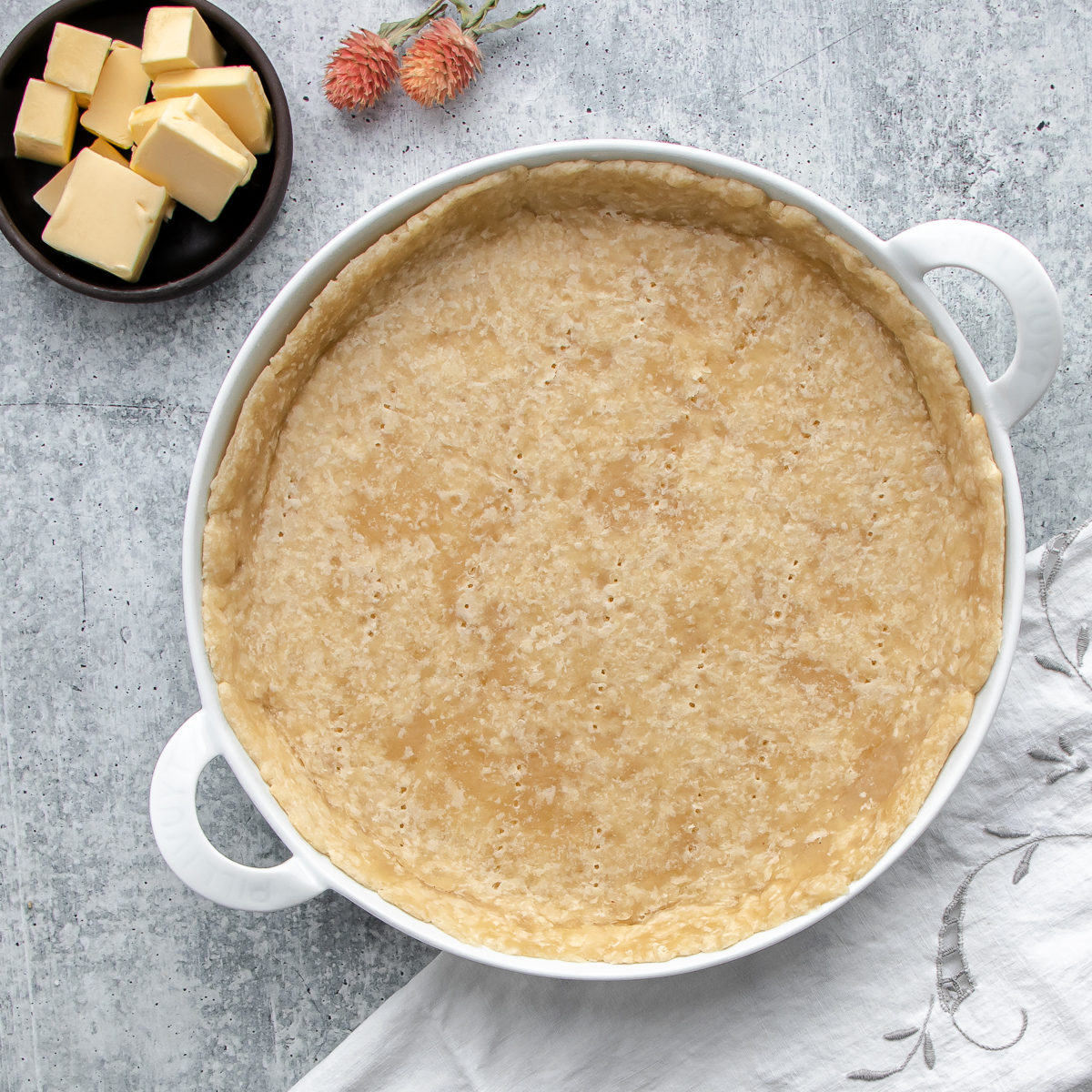
What You’ll Learn
- Introduction To Quiche Crust
- Ingredients Needed
- Step 1: Measure And Mix Dry Ingredients
- Step 2: Cut In Butter
- Step 3: Drizzle In Ice Water
- Step 4: Form Dough Into A Ball
- Step 5: Chill Dough
- Step 6: Roll Out Dough
- Step 7: Transfer To Dish
- Step 8: Partially Blind Bake The Crust
- Tips for making the perfect quiche crust
- My favorite ham and cheese quiche recipe
Introduction To Quiche Crust
Quiche can either be made in a tart pan (shallow) or pie dish (deep). This recipe is mainly focused on using a shallow tart pan so my crust is a little more thin. This shortcrust pastry recipe is nearly identical to my single crust pie dough recipe, except that it requires the blind-baking before adding quiche fillings and egg custard.
Ingredients Needed
When it comes to making flaky, perfect homemade quiche crust the five ingredients are very simple. You’ll need all-purpose flour, salt, granulated sugar, cold unsalted butter cut into small cubes, and very cold water.
Cold ingredients are important because the longer you work with the dough, the warmer and stickier it gets, the more the butter melts, and the harder it will be to work with it. That’s also why you must chill the dough for at least 30-60 minutes before rolling it out, and to be as quick as possible whenever you’re working with the dough.
Do not skip or reduce the sugar. For maximum flavor, sugar reacts with the butter and allows the dough to caramelize in the oven, resulting in a perfectly browned quiche crust.
Equipment Used
I used my french porcelain Toulouse 10.5″ round tart dish by Pillivuyt to make this recipe. Pillivuyt french porcelain heats evenly, is thermal-shock resistant and can be safely transferred from the freezer to a hot oven. The best part? It cleans up extremely well and looks gorgeous for easy serving during the holidays.
My favorite (and easiest!) method to make quiche dough is using a food processor. I use the triple prep system by Nutribullet food processor because it doubles as my blender for smoothies without needing to have two separate small appliances! To make dough by hand, use a pastry dough cutter.
Step 1: Measure And Mix Dry Ingredients
Process flour, salt, and sugar in a food processor for a few seconds until combined. Alternately, you can do this entire process by hand with a medium sized (3 quart) bowl using a pastry cutter or even two forks.
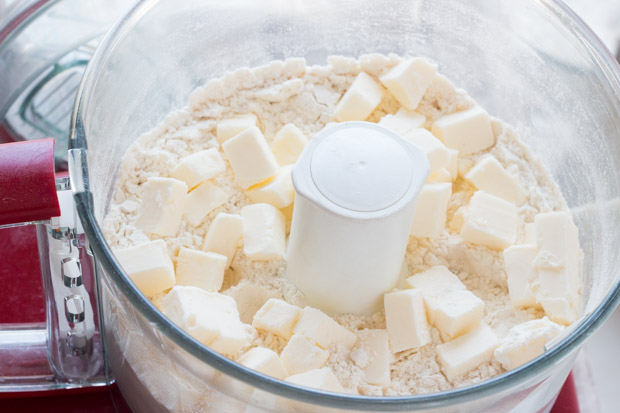
Step 2: Cut In Butter
Add cold butter and pulse until the mixture becomes crumbly and resembles coarse meal, about 15 pulses. Different sizes of butter pieces or some large pieces is fine.
Step 3: Drizzle In Ice Water
Add 2 Tablespoons very cold water and keep pulsing, adding more water as needed, 1 Tablespoon at a time, until the dough isn’t dry and starts to clump together. Do not process to the point that a large ball of dough is formed, rather the dough should be quite crumbly with large clumps. Another way to check if its done is to take a piece of dough and press it between your thumbs. The dough should stick together well without feeling dry or crumbly.
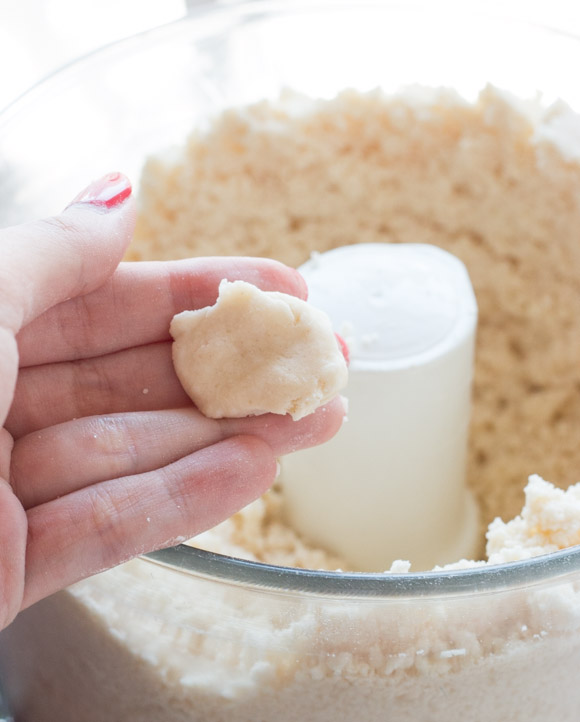
Step 4: Form Dough Into A Ball
Turn the dough to a lightly floured surface and form into a ball. It should come together easily without being sticky. Flatten ball slightly with your hands to form a 1-inch thick disc. I doubled the recipe to make two pie crusts at once.



Step 5: Chill Dough
Wrap the disc of dough with plastic wrap and refrigerate at least 1 hour before proceeding with your quiche recipe. If you don’t want to use the dough right away, you can refrigerate it for up to 3 days or freeze it from up to a month, then thaw it overnight in the fridge.
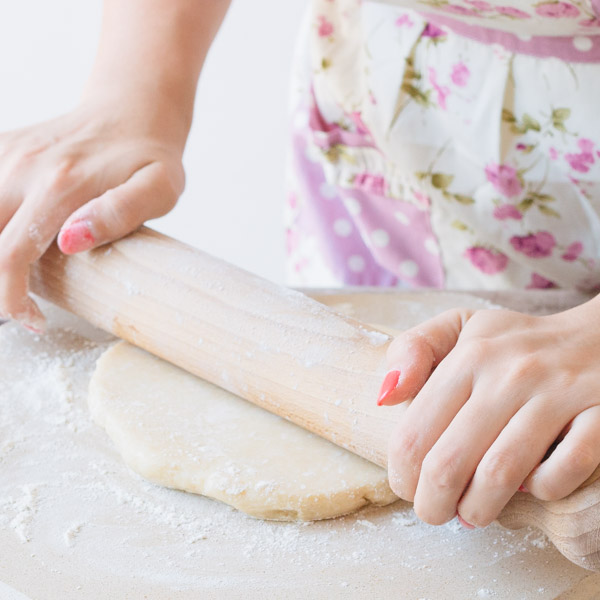
Step 6: Roll Out Dough
On a lightly floured surface, roll out the dough into a large, flat circle until it reaches your desired diameter using a rolling pin. I rolled my dough to about 12.5″ for my 10.5″ shallow tart pan. Alternately, if using a standard 9″ pie plate, roll out your dough to 12″ to leave enough overhang for a decorative crust. The dough will be quite thin, around ⅛″.



Step 7: Transfer To Dish
Lift the dough gently and place it into your baking dish. Avoid putting too much pressure pressing the dough into the pan. Use a light and gentle touch. Trim any excess dough around the top edges of tart pan or crimp dough if using a pie plate. If you’re concerned about the crust shrinking, you can place your dish in the freezer for about 30 minutes, wrapping it tightly with aluminum foil. Frozen dough is less prone to shrinking.

Step 8: Partially Blind Bake The Crust
Blind baking refers to baking the crust in a dish before adding the filling to it. Since the pastry puffs up a little during baking, you’ll need to bake it with pie weights, dry beans, or uncooked rice. A layer of tightly wrapped aluminum foil will separate the dough from the weights. Once the crust is partially baked, you can remove it from the oven. Blind baking prevents the crust from becoming soggy with the egg custard filling.
To blind bake this dough, preheat the oven to 375F/190C. Line the dough tightly with a layer of aluminum foil or parchment paper, covering the edges to prevent them from burning. Fill with 1 lb of pie weights, dried beans, or uncooked rice, making sure they’re fully distributed over the entire surface. Bake crust for 15-16 minutes and remove from the oven, gently lifting the foil and weights. Poke a few holes in the surface of the crust with a fork to remove any air pockets. If the crust needs a little more time, return it to the oven for 2-3 more minutes. It should be dry and very lightly browned.
At this point the crust is only partially baked. Continue on to your quiche recipe at this point to complete the baking process.
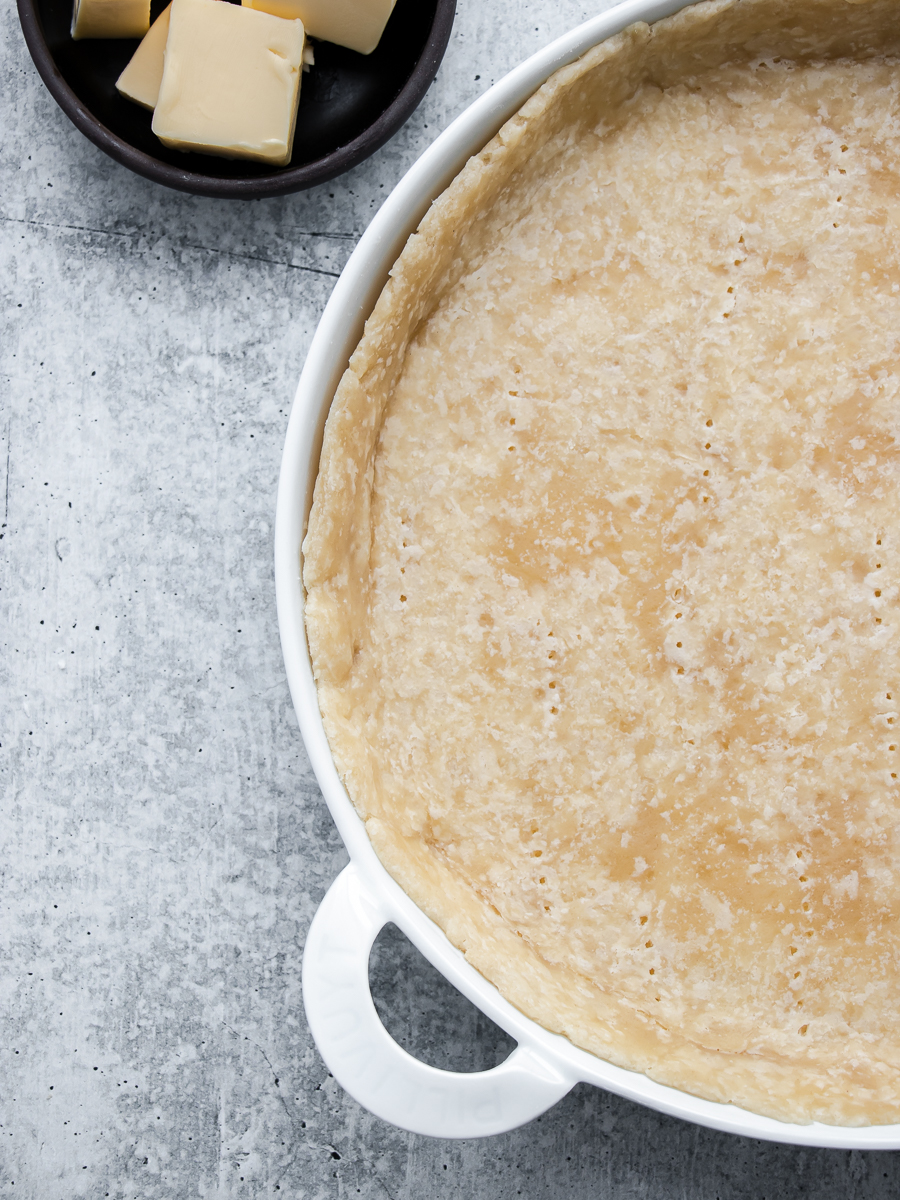
Tips for making the perfect quiche crust
- It’s important to use very cold ingredients when making the dough. Cut the butter into small cubes, then put it in the freezer for 15 minutes. Same for the water and flour – measure the amount you need and place in the freezer to chill. For the water, you could alternatively add some ice cubes, but keep in mind that if you’ve already measured the water, ice cubes melt and will add more liquid.
- Stick to butter instead of shortening. Some recipes contain shortening in addition to butter, which results in a flakier crust, but I use all butter in my recipe for the best flavor. I don’t like to take shortcuts when it comes to my pies and quiches.
- Be careful not to over-process the dough. The more you mix it, the more gluten is formed, which results in a tougher crust. This is why I don’t add the water into the food processor to combine with the flour-butter mixture – once you add water to flour and start mixing, gluten starts to form. Combining the water with the butter-flour mixture in the food processer can overmix the dough, creating a tough, dense pie crust. We don’t want that; we want a dreamy, flaky, crisp texture.
- Chill your dough before rolling it out. Otherwise, the butter will start to melt and the dough will be too sticky to work with.

My favorite ham and cheese quiche recipe
Our local food coop sells a quiche that I’ve tried years to recreate and I’ve finally done it. My ham, gruyere, and swiss quiche with leeks is the gold standard in our house. The secret was whipping air into the eggs and heavy cream, resulting in a light and airy bite of egg custard. Leeks are a mild onion that give a delicate savory flavor that compliments this dish perfectly. Place thin layers of leeks on top to cook delicately in the oven.

Quiche Crust Recipe (Pâte Brisée)
Buttery, crisp, crumbly, and flaky, this is a good old-fashioned quiche and pie crust recipe, also known as pate brisee. Instructions provided through blind baking. At that point, continue on with your quiche recipe.
Ingredients
- 1 ¼ cups (175g/6.2 oz.) all-purpose flour
- ½ teaspoon salt
- 1 tablespoon granulated sugar
- ½ cup (1 stick/113g) cold butter, cut into small cubes
- 2-4 tablespoons (30-60 ml) very cold water
Instructions
Make the dough
-
Process flour, salt, and sugar in a food processor for a few seconds until combined (Instead of food processor, you can do the whole process by hand, using a pastry cutter).
-
Add butter and pulse until mixture becomes crumbly and resembles coarse meal (different size of butter pieces or some large pieces is fine), about 15 pulses. Add 2 tablespoons water and keep pulsing, adding more water as needed, one tablespoon at a time, until the dough isn’t dry and starts to clump together.
Do not process to the point that a large ball of dough is formed, rather the dough should be quite crumbly with large clumps. Another way to check if it’s done, is to take a piece of dough and press it between your thumbs – the dough should stick well together without feeling dry or crumbly.
Chill the dough
-
Turn the dough to a floured surface and form into a ball. It should come together easily without being sticky. Flatten ball slightly with your hands to form a 1-inch thick disc. Wrap with plastic wrap and refrigerate for at least 1 hour before proceeding.
Roll out dough
-
On a lightly floured surface, roll out the dough into a large, flat circle until it reaches your desired diameter. I rolled my dough to about 12.5" for my 10.5" shallow tart pan. I rolled out my dough to 12" for my 9" pie dish to leave enough overhang for a decorative crust. The dough will be quite thin, around ⅛".
-
Lift the dough gently and place it into your baking dish. Avoid putting too much pressure pressing the dough into the pan. Use a light and gentle touch. Trim any excess dough around the top edges of tart pan or crimp dough if using a pie plate. If you're concerned about the crust shrinking, you can place your dish in the freezer for about 30 minutes, wrapping it tightly with aluminum foil. Frozen dough is less prone to shrinking.
Blind bake the crust
-
Preheat the oven to 375℉/190℃. Line the dough tightly with a layer of aluminum foil or parchment paper, covering the edges to prevent them from burning. Fill with pie weights, dried beans, or uncooked rice, making sure they're fully distributed over the entire surface.
-
Bake crust for 15-16 minutes or (17-18 minutes if frozen) and remove from the oven, gently lifting the foil and weights. Poke a few holes in the surface of the crust with a fork to remove any air pockets. If the crust needs a little more time, return it to the oven for 2-3 more minutes. It should be dry and very lightly browned. At this point the crust is only partially baked. Continue on to your favorite quiche recipe at this point to complete the baking process.
Recipe Notes
Make ahead instructions: If you don’t want to use the dough right away, you can refrigerate the dough disc for up to 3 days or freeze it for up to a month, then thaw it overnight in the fridge before using.
Refer to the “How to make quiche crust” article at prettysimplesweet.com for full how-to instructions with step-by-step photos and helpful tips.

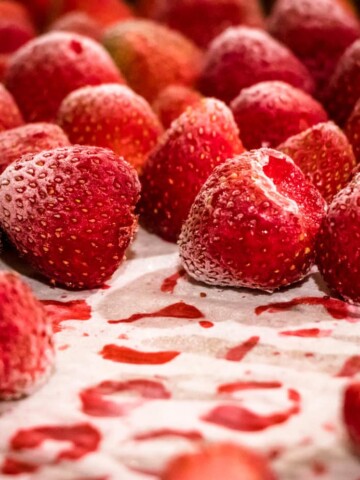
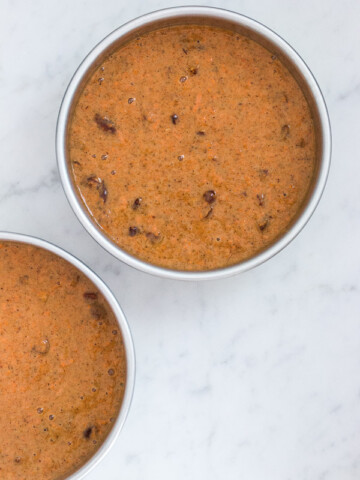

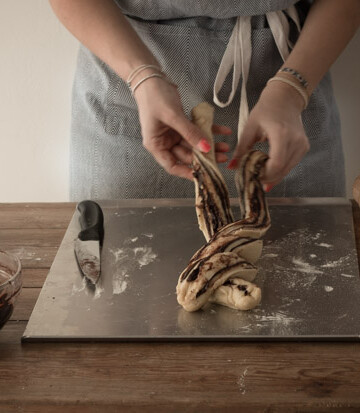
Leave a Reply